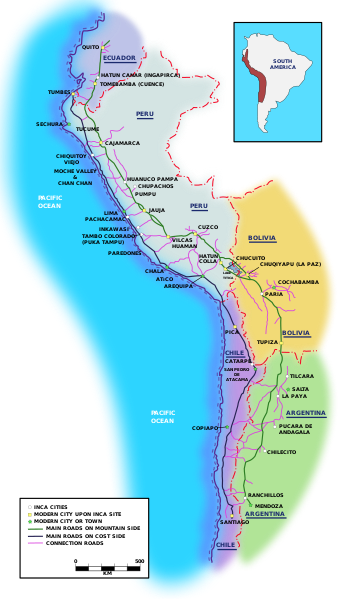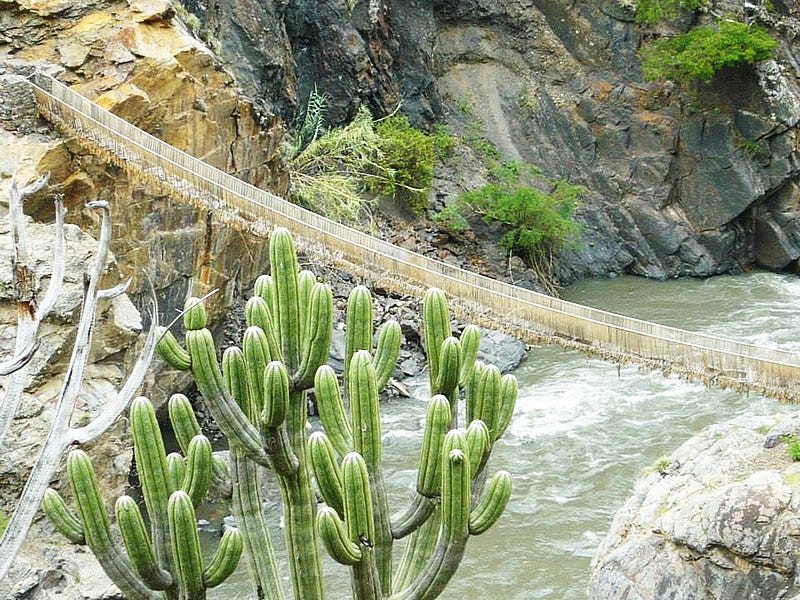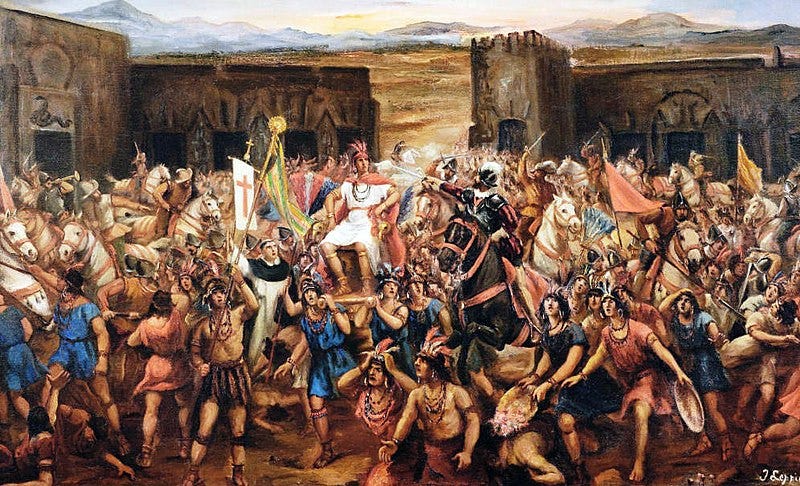Children Of The Sun
An Empire Built In The High Andes

We call these people “Incas” for convenience, but Spanish conquistadores gave them that name. Originally, only their leader was called Inca. In their main language, Quechua (now an official language of Peru), everyone else called themselves: “intip churin” — Children of the Sun.
Their empire became the largest in South America, and included rainforest and arid desert. But most lived in the Andes, at 7.242 kilometres (4,500 miles) long, the world’s longest mountain chain. With more than 100 peaks over 6.000 metres (19,685 feet), it includes volcanoes of the Pacific Ring of Fire.
*As always with history, there are various theories about the parts we don’t know for certain. Within the Inca empire, some traditional storytelling, painting, and songs survived the invasion. The Spanish were first to write about them.
Inca creation story
The Inca creation god was Viracocha, who made the earth and sky. His wife was Pachamama, the earth goddess. Gods of natural phenomena included Inti the sun god (father of the Inca), and gods of rain, earthquakes, and fire. Viracocha made huge clay sculptures and gave these giants life, then turned them to stone and made the new race, and animals.
In 1150, he sent Manco Cápac and his sister Mama Ocllo to populate Cuzco. Much later, Viracocha left, walking across the Pacific and, like most gods, promising to return.
This was the third great civilisation of South America which fatally mistook the Spanish invaders for returning deities. In 1525, when Inca Huayna Cupac was old, a white man arrived, speaking an unfamiliar language…
He was Francisco Pizarro; impressed by Inca wealth, especially gold and silver, he returned to Spain to get royal approval to conquer the region. In the land of the Inca, he had unwittingly left behind organisms that cause smallpox and measles, to which local people had no immunity.
History
Map of the Inca Empire and its roads:

The economy was centralised and land belonged to the community. Society was hierarchical — from the Inca, through governors to farmers, everyone’s importance depended on how many people they commanded. Like the Maya, they practised cranial deformation, to distinguish the nobility.
All celebrated their life stages, from birth to decrepitude and death, and believed in reincarnation. Women had rights to inherit property, and their artesan skills were highly respected, especially spinning and weaving wool or cotton. Men were soldiers as well as farmers, going to war whenever needed.
Certain people, such as the very old, priests, brujos (healers), and the Inca, were allowed to chew coca leaves to relieve hunger and cold. This plant is the source of cocaine; the leaves are still chewed by indigenous people. When an Inca died, he was interred in his palace, and his successor built himself a new one.
Most people lived in stone or adobe houses with dried-grass roofs, which were smoky, with no chimneys and doors of cloth. Patios were shared; they froze potatoes there to make their traditional chuño, and dried maize for storage. Quinoa was also known to the Children of the Sun.
They herded llamas and alpacas, and hunted wild ducks, geese, deer, tapirs, and foxes. They befriended the small, silent, wild dogs for pets, and kept cuis (guinea pigs) indoors for meat.

Artesans and other non-agricultural workers flourished in the cities, developing weaving, pottery, and metalwork with beautiful patterns still used today. Many buildings are still standing, some with huge stones fitted together so perfectly that even a sheet of paper cannot pass between them.
Growth of the Empire
There had been great cities in the Andes before; Tiahuanaco on Lake Titicaca was occupied a hundred years earlier with its Puerta del Sol made from a single rock 9 metres long, while Ayacucho’s Huari civilisation lasted from 600–1100.
The first Inca, Manco Cápac, founded Cuzco in 1150. It was the main city of the Kingdom of Cuzco until 1438. Other Inca cities include Machu Picchu (rediscovered by Hiram Bingham in 1911) and Cajamarca, where the last Inca was imprisoned.
The eighth Inca, Roca, started the expansion towards empire, building vertiginous suspension bridges where Inca roads passed between mountains or over rivers. Herders took local camelids — mainly alpacas and llamas over these bridges.

Cuzco was Tawantinsuyu — the land of four corners, merging Antisuyu (East), Contisuyu (West), Chinchaysuyu (North) and Collasuyu (South) — the perfect centre for an empire.
The ninth Inca, Pachacuti, organised around this, ruling from 1438–1461. He codified laws, and oversaw construction of major roads, including one from the Andes to the coast in 1450.
His rule saw major advances in agriculture, and repair work at Huaca-chaca, where three bridges cross the Apurimac river in the north. Some neighbouring tribes were conquered, others simply incorporated. By his death in 1461, the tribe’s territory extended from Lake Titicaca to Lake Chincha.
Pachacuti was followed by Topa, who used over 25,000 workers to build the great fortress of Sacsahuamán. He also defeated the famous rival empire of the Chimú at their capital, Chan-Chan, in 1466, and introduced the chasqui system (see below).
In 1493, Huayna Cupac became Inca. By 1500CE, the empire had over 10 million inhabitants and was over 4.023 kilometres (2,500 miles) long.
Inca culture was special in many ways
Their location influenced development. For an empire which lasted less than 400 years, and had no draft animals, wheels, iron or steel, their achievements are remarkable.
They farmed on mountain terraces, using land that looked impossible for agriculture. Their markets and trade used no money, but exchanged goods. Taxes were paid by working.
Gold, silver and copper were found locally, so metalworking became a popular skill. Sadly, the Spanish conquistadores melted down much Inca art, so precious metals could be easily transported back to Europe. Pottery and textiles fared a little better, and some excellent examples have been found, including those used in burials.
Many dead were mummified, a process probably discovered by chance. A dead body dries out and is preserved naturally in a desert region. The Incas adapted this for their royalty. Mummies were wrapped in elegant woven clothes and blankets, with grave goods.
Other mummies were sacrifices for specific events (qhapac cocha); such as over 4,000 after the death of Huayna Cupac in 1527. Children were sacrificed to the gods for a good harvest, for rain, or to end a famine. Believing in reincarnation, parents expected to see them again.

Roads and Communication
Their road system was over 4.023 kilometres (2,500 miles) long. Like the Mayas, Incas valued roads for military transport and to facilitate communications and trade.
They had pack animals; mainly llamas, small but strong and sure-footed. People also carried goods, and practised from childhood to carry loads on their backs, secured with straps across their foreheads. Adults could carry over 35 kilograms long distances.
Maintenance of the roads was a duty for Children of the Sun. If a bridge fell, they would rebuild it fast, using heavy ropes made with fibres from a plant called “cabuya;” a huge succulent. Enough ropes wound together were immensely strong.
Roads were also used by the chasquí runners, messengers who ran day and night, in relays. In five 24-hour days, a team could cover 2,000 kilometres. The people could not write, and knew no letters. But the chasquí runners used a unique, effective, and lightweight means of transporting information:
Messages were carried on quipus — horizontal strings with vertical strings hanging from them. Information about all aspects of life in the empire was recorded this way, and they probably also served as memory-aids for storytelling.

The length and colours of the strings, and shape and number of knots all had meaning for the quipucamayoc, trained to interpret them. We are still trying to understand the Inca quipus.
The sun sets on the empire
In 1527, Huayna Cupac and his designated successor, Ninan Cuyuchi, both died, possibly of measles. His oldest son, Huáscar, became Inca of the northern part of the empire, and his second son, Atahualpa, as Inca of the south.
Atahualpa had played a major role in extending and defending the empire, and fought Huáscar for full leadership.
Civil war followed. Huáscar won at Chillopampa, (probably in 1531), but was captured at Chimborazo and decapitated. Atahualpa became the sole Inca in 1532. It is said that he had Huáscar’s skull covered in gold, as a trophy.
Atahualpa’s victory was short-lived. Later in 1532, the conquistador Pizarro returned. He brought only 170 men, one cannon, and 27 horses, but it was enough. Hernando de Soto explored the interior, and brought back an invitation for Pizarro to meet with Atahualpa.
Although the Inca still had an army of around 50,000 he ordered them not to attack the “Viracochas.”
Civil war, trickery, and new diseases all played a role in the empire’s defeat. There are several versions of how this started, but the Spanish attacked the Incas and defeated them at Cajamarca.
They captured Atahualpa and, although he paid a whole room full of gold and twice that quantity of silver as ransom, the invaders deceived him, forced him to convert to Christianity, then executed him on 26 July 1533.

Sporadic fighting against Spanish repression continued, notably the rebellion of Marco Inca. He briefly re-captured Cuzco in 1536 before being forced to retreat to Vilcobamba, in the rainforest. This fortress held out until finally being captured until 1572.
Sources
The Incas, by Victor W. von Hagen, Instituto Cubano del Libro, Editorial Gente Nueva, Havana, 2010.
Joe Scott; The Weirdest Language of All Time is Finally Being Deciphered (About quipus) YouTube https://www.youtube.com/watch?v=81YQbAsJjZA
